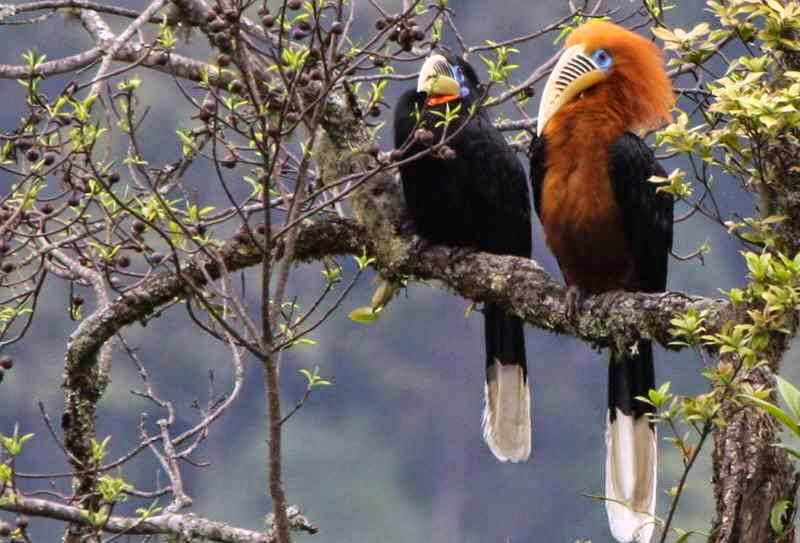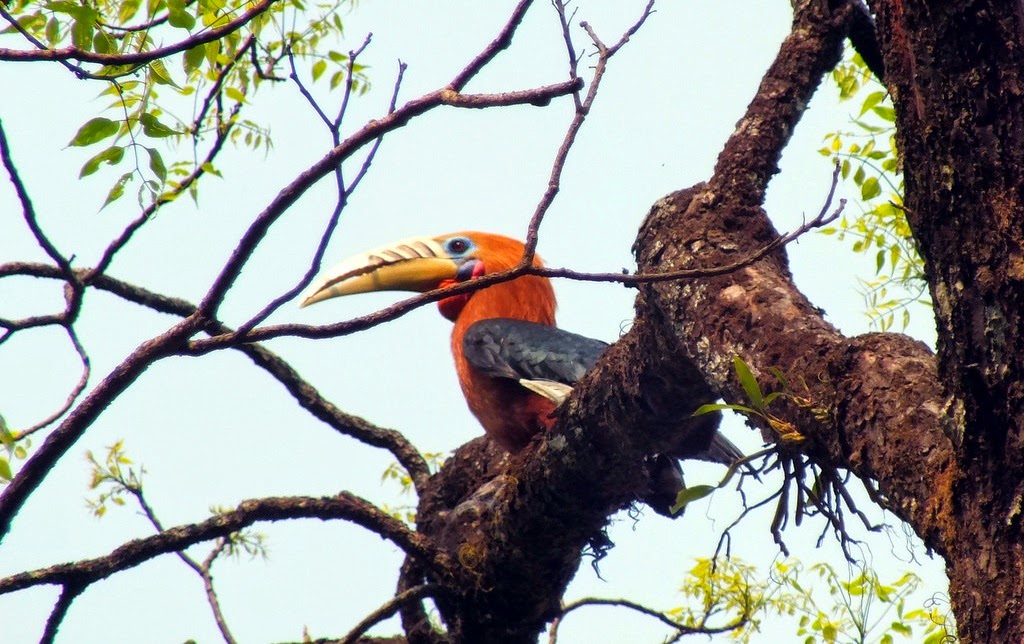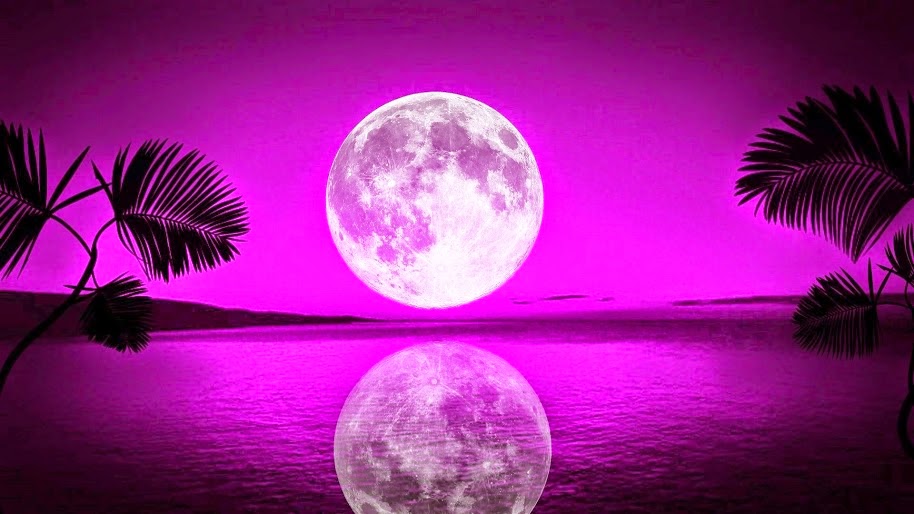This is Gwongurai Falls on the Tooloona Circuit Looks like a pleasant place to be, if not too hot and buggy. The depth of field from the small aperture, the smoothed-out flow from
the extended exposure, and the position placing the large mossy rocks in
the foreground, with the falls coming out of a "hole" of light in the
background
Sunday, 18 May 2014
Bajulmati beach on East Java of Indonesia
Bajulmati beach is
one of the most beautiful beaches in the south of the island of Java. Bajulmati
beach located in Malang regency southern and mileage is about 40 miles south
from the city of Malang. The beach is located 2 miles west from Sempu Island
and 3 miles west from Sendangbiru beach. This region is very enchanting beauty
and is one of the main tourist centers, known in Indonesia and foreign. If you’re
going to Indonesia then its a recommendation.
Labels:
Indonesia
Most Beautiful Bird of South Asia “Rufous-Necked Hornbill”
Rufous-necked Hornbill (Aceros
nipalensis) is a beautiful species of hornbill in the northeastern Indian
Subcontinent and Southeast Asia. Rufous-necked Hornbill numbers had declined
significantly due to habitat loss and hunting, and it has been completely
extirpated from Nepal. It is projected that there numbers are now less than
10,000 adults remaining, with a length of about 117 centimeters, it is amongst
the largest Bucerotine hornbills. The under-parts, neck and head are rich Rufous
in the male, but black in the female. The head, neck, and lower body of the
male are colored Rufous, with deeper coloration on the flanks and abdomen.
However; the middle primaries and the lower half of the tail are tipped white. And
the rest of the hornbill's plumage is a glossy dark-green and black. The specie
lower tail-covert feathers are colored chestnut mixed with black. Whereas on
the other hand “The female”, are black, except for the end-portion of her
tailand the tips of the middle primaries, normally are white. Juvenile
hornbills look like adults of the same sex, but lack the ridges at the base of
the upper beak. The beak absences a true caique but is thickened at its base. Rufous-Necked
Hornbill has a number of dark ridges on the upper beak which are lacking in the
young and increase in number with age up to about seven. The commissure of the
beaks is broken for both sexes.
While mainly a bird of ridged and
hilly forests, primarily broadleaved forests at altitudes of 150–2,200 metres,
it has also been recorded in dry woodland. The nesting period starts from March
to June and the trees being preferred are tall and having broad girths. There
is indication to suggest the Rufous-necked Hornbill communities move seasonally
between one forested areas to another to avail of the differing abundance of
fruiting trees due to local conditions. Therefore; egg shape is broad oval,
compressed slightly towards one end, so as to be slightly pyriform. However;
shell is strong and thick, but coarse and completely glossless, all over pitted
with minute pores. In color it is a very dirty white, with a pale dirty
yellowish tinged, and everywhere obscurely stippled, when carefully observed,
with minute purer white specks, owing to the dirt not having got down into the
bottoms of the pores. In Arunachal Pradesh, Rufous-necked hornbills have been
hunted by tribal for their feathers and beak. Rufous-Necked Hornbill can found
in Bhutan, China, Myanmar, Laos, Thailand, Vietnam and northeast India, the
rufous-necked hornbill has suffered a massive population decline, and is believed
to be extinct in its historical array country, Nepal. The rufous-necked
hornbill existing in little numbers in a large number of reserves, sanctuaries
and national parks across its range, but the popular of these areas would
benefit from improved management systems.
Labels:
Birds
Saturday, 17 May 2014
Friday, 16 May 2014
Thursday, 15 May 2014
Full Moon Reflection
A full moon is the lunar phase
that occurs when the moon is totally illuminated as seen from the earth. This happens
when it is on the opposite side of the Earth from the Sun; more exactly, when
the ecliptic longitudes of the Sun and Moon differ by 180 degrees. This means
that the hemisphere of the Moon that is facing the Earth is almost entirely
illuminated by the Sun and appears round while the far side is almost
completely un-illuminated.
Lunar eclipses can happen only at
full moon, where the moon's orbit lets it to pass through the Earth's shadow.
Lunar eclipses do not happen every month because the moon generally passes above
or below the Earth's shadow which is mostly restricted to the ecliptic plane.
Lunar eclipses can happen only when the full moon occurs close to the two nodes
of the orbit, either the ascending or descending node. This reasons eclipses to
only happen about every 6 months, and often two weeks before or after a solar
eclipse at new moon at the opposite node.
The time interval between similar
lunar phases the synodic month averages about 29.53 days. As a result, in those
lunar calendars in which each month begins on the new moon, the full moon falls
on either the 14th or 15th of the lunar month. Since calendar months have a
whole number of days, lunar months may be either 29 or 30 days long.
Labels:
Science
Chogolisa is a mountain in the Karakoram region of Pakistan
Chogolisa is a mountain in the Karakoram region of
Pakistan. It lies near the Baltoro Glacier in the Concordia region which
is home to some of the highest peaks of the world. Chogolisa has
several peaks, the highest on the SW face (Chogolisa I) rises to 7,665
metres (25,148 ft). The second highest at 7,654 metres on the NE side
(Chogolisa II) is the one named Bride Peak.
Labels:
Pakistan
Saturday, 10 May 2014
Baby Sand Cat
Don't be fooled
by cute overload, the Sand Cat (Felis Margarita) is a little-known species of
desert cats. They live in the harshest deserts of Asia and Africa. They are very
comfortable in environments but other wildcats cannot easy to handle, like the
Sahara and Arabian deserts as well as those of Pakistan and Iran.
Sand cats looks alike domestic cats, but they are larger and
thicker, particularly around the head. Their ears are wider apart which
flattens out when crouching down for the hunt. Fur lines their under-paws and
between the toes to protect against the scorching sand.
The most unbelievable fact is this cat can go for months
without drinking water! Strangely, as a wildcat they are not afraid of humans.
This cat is simply brave and definitely impressive.
Labels:
Animals
Subscribe to:
Posts (Atom)




























